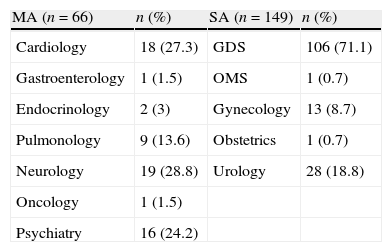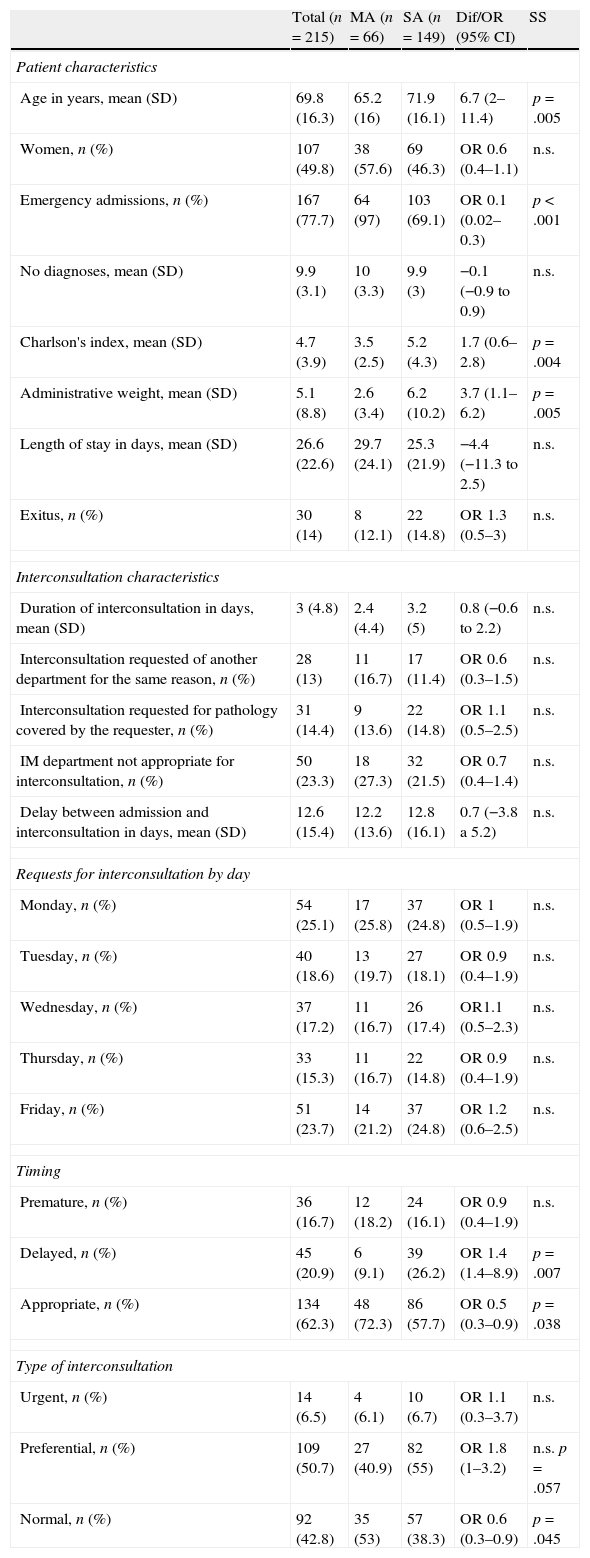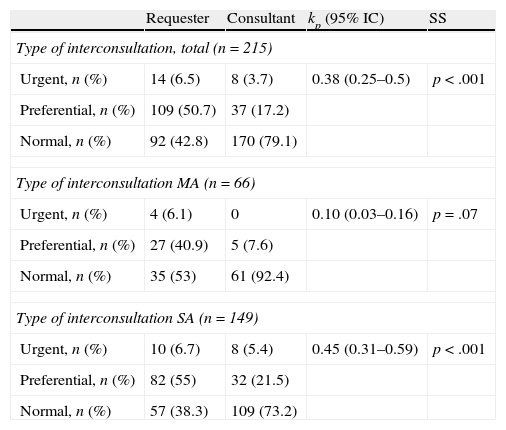An important but understudied activity of the departments of internal medicine (IM) is the in-hospital consultations. We analyzed the requests for in-hospital consultation with IM and the potential differences between the consultations of medical and surgical departments.
Patients and methodsThis was an 8-month observational prospective study that analyzed demographic variables related to the origin of the interconsultation, comorbidity, length of stay and hospital mortality, emergency, admission-consultation request delay, appropriateness (not appropriate if another department was consulted for the same reason or if the pathology behind the consultation was that of the requesting service) and, for patients who underwent surgery, whether it was requested before or after the surgery.
ResultsDuring the study, 215 in-hospital consultations were conducted (27 consultations/month). The mean age of the patients was 69.8 years (women, 50%). Some 30.7% were requested by medical departments and 69.3% by surgical departments. Thirteen percent of the in-hospital consultations were duplicated. The department of IM was not the appropriate department consulted in 23.3% of cases (13.0% of the cases requested consultations for the same reason with another department; in 14.3% of the cases, the pathology was that of requesting department). More in-hospital consultations were conducted on Mondays and Fridays than on Thursdays (25.1% and 23.7% versus 15.3%, respectively; p=.03). The delay between admission and the request for interconsultation was of 12.6 days. Some 90.7% of the in-hospital consultations for patients undergoing surgery were requested after the intervention. There were no differences in the characteristics of the in-hospital consultations between the medical and surgical departments.
ConclusionsIn-hospital consultations directed at IM are frequently duplicate, are not well directed at the appropriate department and their urgency is incorrectly assessed. These characteristics are similar for the consultations with medical and surgical departments.
Una actividad importante y poco estudiada de los servicios de medicina interna (MI) son las interconsultas. Hemos analizado las solicitudes de interconsulta a MI y posibles diferencias entre las consultas de los servicios médicos y quirúrgicos.
Pacientes y métodosEstudio observacional prospectivo de 8 meses de duración. Se analizaron variables demográficas, relacionadas con la procedencia de la interconsulta, comorbilidad, estancia y mortalidad hospitalaria, urgencia, demora ingreso-solicitud, adecuación (no adecuado si otro servicio había sido consultado por el mismo motivo o porque la enfermedad motivo de consulta era propia del servicio solicitante) y, en los pacientes intervenidos quirúrgicamente, si fue solicitada antes o después de la intervención.
ResultadosEn el tiempo de estudio se recibieron 215 interconsultas (27 consultas/mes). La edad media fue de 69,8 años (mujeres 50%). El 30,7% fueron solicitadas por servicios médicos y el 69,3% por servicios quirúrgicos. Un 13% de las interconsultas estuvieron duplicadas. El servicio de MI no era el servicio consultado adecuado en el 23,3% (13,0% solicitadas por el mismo motivo a otro servicio y en el 14,3% la enfermedad era propia del servicio solicitante). Los lunes y viernes se formularon más interconsultas que los jueves (25,1 y 23,7% versus 15,3%; respectivamente, p=0,03). La demora entre el ingreso y la solicitud de interconsulta fue de 12,6 días. El 90,7% de las interconsultas solicitadas a pacientes intervenidos se emitieron después de la intervención. No hubo diferencias en las características de las interconsultas entre los servicios médicos y quirúrgicos.
ConclusionesLas interconsultas dirigidas a MI con frecuencia son duplicadas, no están bien dirigidas al servicio adecuado y se aprecia una incorrecta valoración de su urgencia. Estas características son similares para las consultas de los servicios médicos y quirúrgicos.
Article
Diríjase desde aquí a la web de la >>>FESEMI<<< e inicie sesión mediante el formulario que se encuentra en la barra superior, pulsando sobre el candado.

Una vez autentificado, en la misma web de FESEMI, en el menú superior, elija la opción deseada.

>>>FESEMI<<<









